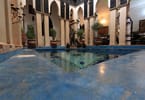(eTN) – “Wait for a little while and you will see something done” is the quote captured when Tanzania’s Minister for Transport Dr. Harrison Mwakyembe last week talked about the government’s unchanged plans to build a new sea port at the heart of the Coelacanth Marine National Park at Mwambani near Tanga, where incidentally a fully-fledged port already exists.
Following the discovery in 2003 of the Coelacanth prehistoric fish, the Tanzanian government rushed to create a dedicated marine national park to afford this rarest of deep sea species the protection it needed to survive, one of the few places where it is still found on the planet. The new park was launched officially in 2009, and earlier this year, as reported here, efforts were made to expand the park boundaries onto land, attempting to make guest houses, resorts, and hotels subject to licensing fees and even private visitors to residents in the area to pay entrance fees.
Understandably, residents objected to this land-grabbing scheme as the proposed boundaries extended deep into the municipality of Tanga and the surrounding villages, leading to a temporary retreat from the authorities involved in this saga.
Conservationists welcomed the creation of a marine national park in 2009 as ground breaking at the time and hailed the speed with which this was undertaken, but are now equally concerned about plans to build a new harbor in the middle of what is a relatively shallow Mwambeni bay. This plan would necessitate extensive dredging of a port entrance from the open sea as well as having to create berths for ships, wrecking the habitat of the rare prehistoric fish species and irrevocably altering the fabric of the marine park, and quite possibly condemning it to ruin.
Towards that end, residents were told they had to give up their land, some of them for the second time in two decades, and according to local sources done by a combination of deception and threats should the inhabitants of fishing villages not leave voluntarily from the land of their ancestors. Local law firms contacted by affected residents to commence legal action quietly turned them down, in some cases citing intimidation from the “powers that be,” and told they would face a myriad of problems for their firms including the loss of lucrative contracts, leaving observers exasperated that in this day and age a government could still resort to such measures. Some residents who reportedly left later on found out that their land had been resold to “investors,” raising tension among those still refusing to go and setting local communities on a collision course with distant bureaucrats, who are allegedly smelling a major payday on the horizon.
Studies about the port, in part at least financed by the World Bank, also seem to have omitted or blatantly avoided the required stakeholder consultations, with either no known invitations issued to those directly affected or else only a carefully selected few being heard, defeating the due process and making a mockery of World Bank requirements, if true. A mandatory requirement for an Environmental Impact Assessment (EIA), under Tanzanian law and regulations, has also not been undertaken, further faulting the entire process of promoting the building of a deep sea port, unless the government is hell-bent, as seen incidentally with other equally dubious projects, to do as they please come hell or high water.
Consultants who have worked on the project have also quietly and off the record let it be known that they were subject to pressures to reach pre-determined outcomes and to specifically exclude references to the marine national park and the entire complex of questions arising from it. Other consultants who reported about the pros and cons of expanding Tanga versus a new port are equally sullied by allegations that the geographics and contours of Mwambani bay have not been sufficiently captured when comparing the need to excavate the existing port’s inbound channel. This is clearly needed to allow larger vessels to dock and expanding the existing berths to the deep sea portion of the port or else also dredge deeper. It is by conventional wisdom generally considered to be the much more economical option compared to building an entirely new port, and inside a marine national park for that matter.
Related reports published here in May last year and available via this link www.wolfganghthome.wordpress.com/2011/05/01/tanzania-conservation-breaking-news-the-corridor-of-destruction-from-the-coast-to-the-lake/ already back then raised questions and painted scenarios on the wall, first denied, then bedeviled, and now, by the look of it, proven entirely correct.
Local residents and tourism businesses, the latter understandably not going on record as a result of the Tanzanian government’s notorious record of muzzling dissent with strong arm tactics and even criminalizing objectors, have expressed their hope that should all else fail, they would find ways and means to take their grievances to the East African Court of Justice in Arusha. That independent judicial organization of the East African Community had earlier in the year specifically overruled the Tanzanian government’s objections in the appellate division about hearing the Serengeti Highway case, and the court registrar then publicly stated that East Africans are most welcome to take such cases to the EACJ should they not get justice in their national jurisdictions.
Tanzania’s insistence to go ahead with such hugely controversial projects like the Lake Natron soda ash factory, the Serengeti highway, and possible parallel railway linking Tanga with Musoma on Lake Victoria, the extraction of Uranium from a 200-square-kilometer zone just due to be carved out of the Selous Game Reserve or the Stiegler’s Gorge hydro-electric project which would flood much of the core tourism area of the world’s largest game reserve, are all evidence that not all is well. Clearly there are powers at work within the Tanzanian government, either completely ignorant or else dismissive of the environmental consequences of their planned actions or otherwise being willing partners to global conglomerates intent to mine the country’s riches, siphon the proceeds away, and leave fat “considerations” for a few and generally peanuts for the people – plus a trail of destruction and environmental ruins.
Local contributors from Tanzania have been lamenting the 180 degree U-turn by their government vis-a-vis the conservation-minded leadership of founding father Mwalimu Julius Nyerere, who had joined hands with Prof. Dr. Grzimek to protect the Serengeti and give Tanzania the global recognition as a leading conservation nation it enjoyed for many decades. No longer it seems, as Mwalimu must be turning in his grave when he sees what his political grandchildren of today are up to. Much fodder for thought, many questions ask and as usual, very likely no substantive answers given other than shooting the messenger again.
WHAT TO TAKE AWAY FROM THIS ARTICLE:
- Following the discovery in 2003 of the Coelacanth prehistoric fish, the Tanzanian government rushed to create a dedicated marine national park to afford this rarest of deep sea species the protection it needed to survive, one of the few places where it is still found on the planet.
- Conservationists welcomed the creation of a marine national park in 2009 as ground breaking at the time and hailed the speed with which this was undertaken, but are now equally concerned about plans to build a new harbor in the middle of what is a relatively shallow Mwambeni bay.
- Consultants who have worked on the project have also quietly and off the record let it be known that they were subject to pressures to reach pre-determined outcomes and to specifically exclude references to the marine national park and the entire complex of questions arising from it.






















